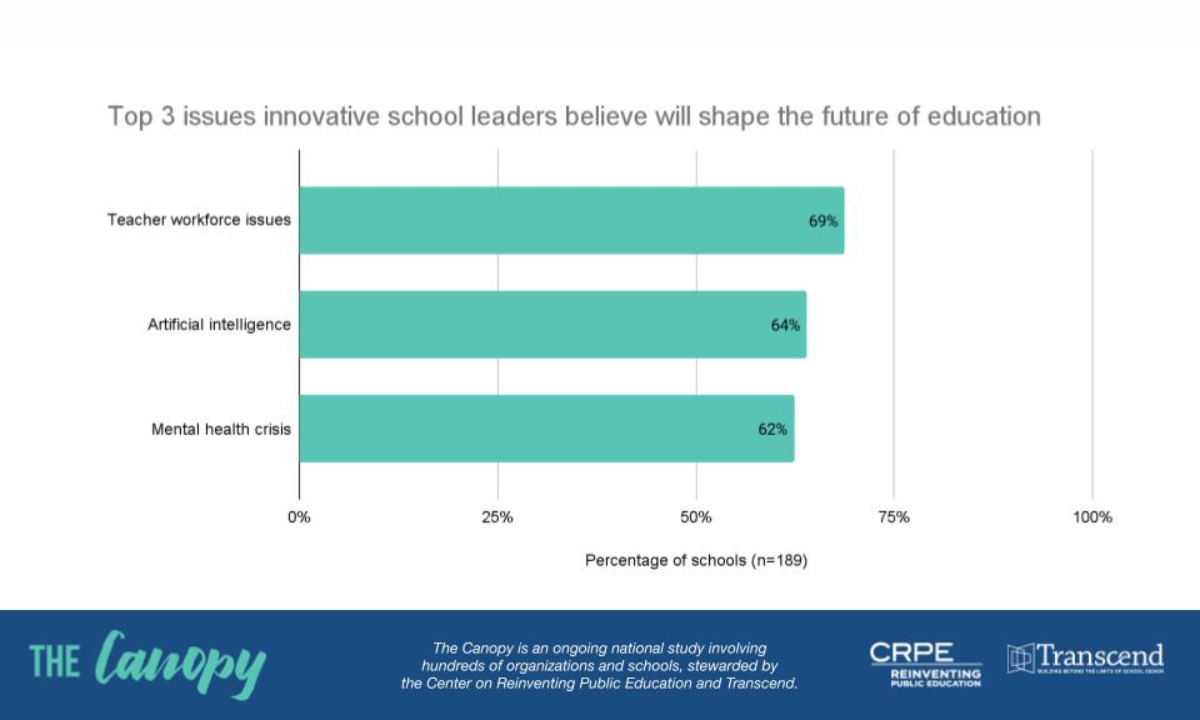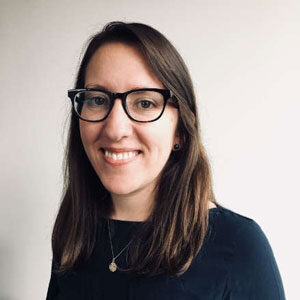189 Innovative School Leaders: Teacher Staffing, AI, Mental Health Top Ed Issues
Waite: Latest Canopy Project survey identifies educators' leading concerns — and what some cutting-edge schools are doing to address them.

Get stories like these delivered straight to your inbox. Sign up for The 74 Newsletter
A common set of problems are keeping education leaders up at night: Will there be enough teachers to staff America’s schools? Can artificial intelligence enhance learning without deepening inequality? How can educators address the mental health crisis among young people? None of these have easy answers.
New data confirm that these issues are top of mind for school leaders, and that education innovators are working to find solutions. The Canopy project, an ongoing national study of schools that focus on designing student-centered and equitable learning environments — and challenge assumptions about what school must be — just updated its database with survey results from 189 innovative schools.
In the survey, most participants agreed that teacher workforce issues, AI and the mental health crisis will shape the future of education. They are also working on solutions — but are concerned about having adequate resources to sustain those efforts.

School leaders selected teacher workforce issues as the top factor that they think will transform the education sector. While some respondents said they have struggled to recruit teachers in general, they particularly have trouble finding those with skills geared to working with non-traditional instructional models. A leader from Bostonia Global, a charter school that’s part of Cajon Valley Unified School District in California, wrote that credentialing programs need to “shift to meet the needs of our current and future workforce.” The school’s competency-based instructional model requires teachers to implement an individualized approach, not just teach the same content at the same pace to a classroom of 30 kids.
Canopy’s survey data show that many schools are innovating to solve these workforce-related issues: 65% reported they implement some form of flexible or alternative staffing model. For example, the Center for Advanced Research and Technology, a high school that enrolls students from two partner districts in California, brings in industry professionals to work alongside teachers. Several Canopy schools foster collaboration, using staffing models such as Opportunity Culture, which provides mentorship, opportunities for small-group teaching and professional development.
Artificial intelligence was the second most-selected driver of change. School leaders’ responses showed they want to harness its potential while staying attentive to issues of access, privacy and equity. Only 7% of Canopy school leaders said they have a policy in place governing students’ use of generative AI, but 38% said they’re developing one. Despite the shortage of formal policy, experimentation appeared abundant.

Howard Middle School for Math and Science, based at Howard University, said the school’s policy is to use AI “to enhance educational outcomes, personalize learning experiences and streamline administrative tasks, while ensuring the safety, privacy and well-being of all students and staff. Anastasis Academy, an independent microschool in Colorado, wrote, “We have trained a GPT on our model, our writings and our curriculum to help personalize learning.”
The mental health crisis claimed the third spot on the list of factors that school leaders believe will transform K-12 education. Four in five leaders reported that their schools are already integrating social and emotional learning into all subject areas and student activities, making it one of the practices most commonly implemented across Canopy schools this year. Additionally, two-thirds of schools surveyed provide mental health services to students, either directly or through a partner like a community-based health organization, and just under half said they support adult wellness, too.
Some responses pointed to an even bigger problem beyond students’ acute mental health needs: battling despair about what the future may hold. One leader wrote, “Students are developing an increasing sense of hopelessness about the world beyond school.” Many lower- and middle-income young people, he said, feel that social mobility is “not possible for them.”
Many schools are working toward solutions that combat that sense of hopelessness. As in previous years of Canopy surveys, most schools reported designing solutions to meet marginalized students’ needs. At BuildUp Community School in Alabama, the school’s mostly Black and economically disadvantaged students split their time between classrooms and work-based learning in construction and real estate, revitalizing their communities and paving a path to homeownership. And 5280 High School, in Colorado, helps students recovering from addiction to reengage in their education and explore their passions in a setting that prioritizes mental health.
A majority of leaders worried about their ability to sustain resources in the coming years. Of those, the top concerns were the availability of local public, private and philanthropic funding. Over a third of those with concerns also said they worried about staffing shortages, inflation and the expiration of federal stimulus funding.

A few leaders pointed out that inadequate funding will not just make it harder to keep the lights on — it will stunt the development of innovative ideas to solve the enormous challenges ahead. Indeed, recent reporting shows reduced philanthropic investment in broader systemic change in the sector.Funding shortfalls in many districts and states will also mean even basic education services may lack adequate resources, making it harder for leaders to defend funding for higher-risk innovation efforts.
Too often, the scale of K-12 sector problems lead education leaders, policymakers and funders to bemoan a lack of bold solutions or flock to attractive but still-theoretical ideas that fail in the implementation stage. School-level innovation efforts are worth watching because they show unconventional ideas in the process of becoming reality — and some may hint at what success can look like. Canopy schools are prime examples of this, whether it’s a New York City charter school accelerating student learning and well-being through summer programming or a North Carolina district school achieving high growth rates with an innovative staffing approach.
The Canopy project will release a full research report later this year. For now, the headlines from this year’s survey should prompt education leaders, policymakers and funders to take note of schools, like those in Canopy’s national dataset, that are working toward bold and unconventional solutions.
Indeed, one answer to what will drive K-12 transformation in the coming years is that it will arise from innovation not just in ed tech companies and think tanks, but in the nation’s schools.
Get stories like these delivered straight to your inbox. Sign up for The 74 Newsletter


